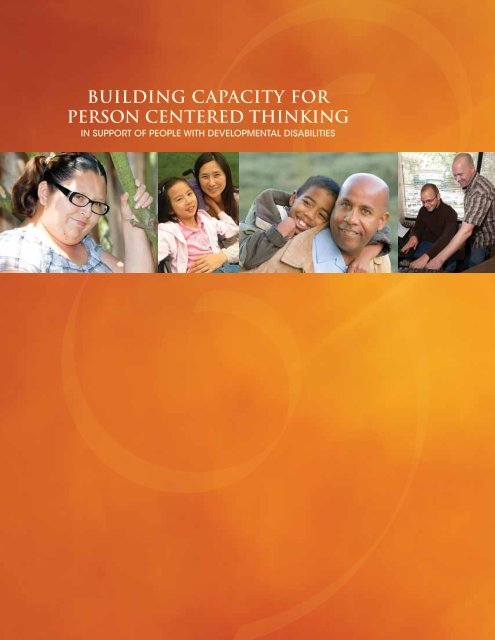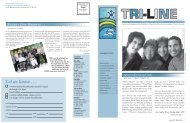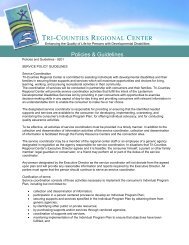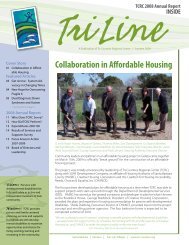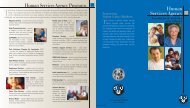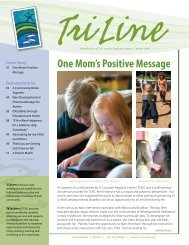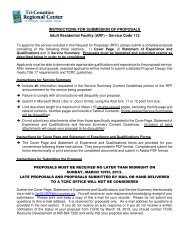building capacity for person centered thinking - Tri-Counties ...
building capacity for person centered thinking - Tri-Counties ...
building capacity for person centered thinking - Tri-Counties ...
Create successful ePaper yourself
Turn your PDF publications into a flip-book with our unique Google optimized e-Paper software.
AcknowledgmentsThis publication represents the work of partner agencies serving individuals withdevelopmental disabilities on the central coast of Cali<strong>for</strong>nia. It was made possiblethrough generous grant funding of the Weingart Foundation, a non-profit foundationdedicated to meeting the needs of the under-served and the general community.Located in Los Angeles, the Weingart Foundation is a major philanthropicfoundation serving Southern Cali<strong>for</strong>nia.Partner Agencies of the Person Centered Thinking Training Collaborative:Channel Islands Social Services (CISS)Eastern Los Angeles Regional Center (ELARC)Genesis Developmental Services (GDS)PathPointPeople Creating Success, Inc. (PCS)<strong>Tri</strong>-<strong>Counties</strong> Regional Center (TCRC)Special thanks to the following contributors:Tina Calderaro-Mendoza, Person Centered Thinking Coordinator, TCRCMeredith Catalini, Vice President, Programs, PCSRon Dodgen, Chief Executive Officer, Genesis Developmental ServicesPatricia Forgey, Director, Community and Organizational Development, TCRCSue Goss, Quality Assurance Coordinator, Genesis Developmental ServicesLiz Harrell, Training and In<strong>for</strong>mation Director, ELARCFran Jorgensen, Assistant Director, Services and Supports, TCRCMary Beth Lepkowsky, Organizational Development Manager, TCRCLisa Padgett, Vice President, Quality Improvement, PathPointLiz Rodgers, Autism Specialist, ELARCHeather Wennergren, Media and Training Coordinator, TCRCEdith Wysinger, Family Services Manager, CISS“Not only do the TCRC staffinterviewed acknowledge the positivechanges resulting from PCT initiativeand practices at the organizationallevel, they also believe that PCTpractices have made changes on a<strong>person</strong>al level, affecting positively boththeir professional and <strong>person</strong>al lives.”~Mian Wang, PhD, Professor of SpecialEducation, University of Cali<strong>for</strong>nia,Santa BarbaraPhotographyWendy Guerrero Photography and various contributorsReferences to Person Centered Thinking tools are based on work developed byThe Learning Community <strong>for</strong> Person Centered Practices. For more in<strong>for</strong>mation,go to www.learningcommunity.us and www.helensandersonassociates.co.uk2
Introduction<strong>Tri</strong>-<strong>Counties</strong> Regional Center (TCRC)together with Eastern Los Angeles RegionalCenter, Genesis DevelopmentalServices, People Creating Success,PathPoint and Channel Islands SocialServices <strong>for</strong>med a Person CenteredThinking Training Collaborative in 2007to build <strong>capacity</strong> <strong>for</strong> implementingPerson Centered Thinking practicesacross participating organizations andthroughout Ventura, Santa Barbara andSan Luis Obispo <strong>Counties</strong>. The PersonCentered Thinking training initiativewas one of sixteen projects, funded bythe Weingart Foundation DevelopmentalDisabilities Initiative, with the sharedgoal of strengthening internal organizationalcapacities in order to sustainexisting services, while enabling newprogram growth and development.The Person Centered Thinking TrainingCollaborative set out to utilize PersonCentered Thinking (PCT) tools andpractices to influence individual andorganizational change, resulting inan enhanced workplace that reflectscore <strong>person</strong> <strong>centered</strong> <strong>thinking</strong> principlesof respect, trust, partnershipand collaboration. As an organizationis strengthened by <strong>person</strong> <strong>centered</strong>practices deeply embedded in dailywork, employees in turn, are betterequipped to provide <strong>person</strong> <strong>centered</strong>services and supports to people withdevelopmental disabilities and theirfamily members.This publication highlights stories aboutthe collective journey of six organizations,each unique in size, geography andcomposition, but all equally committedto creating positive change through<strong>person</strong> <strong>centered</strong> practices. Included arereflections on our accomplishments,key insights and recommendations insupport of other organizations seekingto introduce a <strong>person</strong> <strong>centered</strong> <strong>thinking</strong>culture within their own workplace.Collaborative partners describe howthese practices have impacted thework culture of their agencies and thelives of individuals they serve who livewith a developmental disability.Read about our partnership with theUniversity of Cali<strong>for</strong>nia, Santa Barbarato learn about the impact of PersonCentered Thinking practices. Resultsof the collaborative work and researchsuggest that Person Centered Thinkingis a promising practice that contributesto enhanced organizational culture andimproved <strong>person</strong>al outcomes <strong>for</strong> <strong>person</strong>swith developmental disabilities.This publication also provides an overviewof seven foundational PersonCentered Thinking Tools, developed bythe Learning Community <strong>for</strong> PersonCentered Practices. We hope that bysharing what we have tried and learnedduring this initiative we will encourageother organizations to create <strong>person</strong><strong>centered</strong> environments.5
Introduction to PersonCentered Thinking Tools"Change begins with learning to plan with the <strong>person</strong> served and supported rather than planning <strong>for</strong> them."~Mian Wang, PhD, Professor of Special Education, University of Cali<strong>for</strong>nia, Santa BarbaraImportant To / Important ForImportant to?What else do we need to learn/know?Important <strong>for</strong>?PurposeThis tool defines what is important TO and what is important FOR a <strong>person</strong>while working towards balance.Important TO represents what matters most to a <strong>person</strong> as communicatedin their own words or behavior.Important FOR represents what is needed to keep a <strong>person</strong> healthy, safeand a valued member of their community.PCT ToolsPerson Centered Thinking training introducesseven PCT skills and tools as away to build <strong>capacity</strong> <strong>for</strong> <strong>person</strong> <strong>centered</strong>practices. These function as tools<strong>for</strong> in<strong>for</strong>mation gathering, decisionmaking and action planning. Tools areapplicable in working with individuals aswell as within organizations. Throughoutthis section, examples of these tools areshared, the first of which is Important To/ Important For. This tool is a core conceptof Person Centered Thinking. It isthe basis <strong>for</strong> deeper understanding anda lens through which additional toolsmay be considered. These tools ensurethat the perspective of the <strong>person</strong> servedis at the center of the process.These tools are based upon the workof Michael Smull in collaboration withmembers of the The Learning Community<strong>for</strong> Person Centered Practices. Theapplication of Person Centered Thinkingin daily work affects positive change <strong>for</strong>both individuals and organizations.Benefits• This tool differentiates the voice of the <strong>person</strong> receiving support fromthe voice of the professional or program.• When we balance what matters most to a <strong>person</strong> and what is needed tokeep them healthy and safe we are better equipped to provide supportsthat make sense.Possible Uses• To better understand a <strong>person</strong>’s wants and needs• Be<strong>for</strong>e an action plan is created• To help people get better lives8ExampleOur service coordinators use the PCT tool, Important To and For todevelop a plan that best reflects a <strong>person</strong>’s needs, hopes and dreams. Whenlegislation impacts policy, we also use this tool to engage our stakeholdercommunity in conversations about what is Important To and For the <strong>person</strong>served, the service provider, regional center and the community at large todetermine how best to implement system-wide changes. ~ TCRC
Part II: Strategies <strong>for</strong> SuccessfulImplementation <strong>for</strong> PersonCentered PracticesSix Organizations ShareTheir StoryFrom 2007 to 2011, six partner agenciesof the PCT Training Collaborativeworked together to build organizational<strong>capacity</strong> <strong>for</strong> implementing <strong>person</strong> <strong>centered</strong>practices. The experiences werediverse as each organization utilizedvarying strategies on the path to implementation.The following stories highlightthe accomplishments, challengesand insights of each organization.• <strong>Tri</strong>-<strong>Counties</strong> Regional Center• People Creating Success, Inc.• PathPoint• Channel Islands Social Services• Genesis Developmental Services• Eastern Los Angeles Regional Center9
<strong>Tri</strong>-<strong>Counties</strong> Regional Center<strong>Tri</strong>-<strong>Counties</strong> Regional Center coordinates supports and services <strong>for</strong> children and adults with developmental disabilities living in SanLuis Obispo, Santa Barbara and Ventura <strong>Counties</strong> so that they may live fully and safely as active and independent members of ourcommunity.10AccomplishmentsWe launched a training initiative tobuild <strong>capacity</strong> <strong>for</strong> <strong>person</strong> <strong>centered</strong>practices. This multi-year plan includestraining staff, service providers, familiesand adults served and other interestedcommunity members. Training in PersonCentered Thinking is required of all newstaff and rein<strong>for</strong>ced through modelingand coaching support from managers.Communities of Practice, an opportunityto come together with others <strong>for</strong>sharing of learning, is offered in eachregional location to augment trainingand build confidence in using PCT tools.Additional training opportunities areavailable to all stakeholders to embed<strong>person</strong> <strong>centered</strong> skills and practices indaily work and life.Early in the initiative, we designateda core group of staff and service providerpartners to serve on a PCT TaskForce. The purpose of this group’swork was to develop a strategy toembed <strong>person</strong> <strong>centered</strong> practicesacross the organization. A pilot groupgradually expanded to an agencywide implementation process throughthe support of various sub committees,the work of the TCRC leadershipteam and a dedicated PCT Coordinatorposition. Ongoing collaborationwith partner agencies has contributedgreatly to the success of the initiative.Our commitment to <strong>person</strong> <strong>centered</strong>practice has contributed to the followingorganizational changes that reflecta significant shift in our work culture:• By adopting a guiding principle to be“Person Centered in All We Do”, weremain focused on our goals aroundexpansion of this initiative.• Our commitment to using “PeopleFirst Language” contributes to amore respectful environment, helpingus focus on individuals, ratherthan disabilities.• Revisions to policies, <strong>for</strong>ms and documentssuch as our IPP (IndividualizedProgram Plan) reflect <strong>person</strong><strong>centered</strong> principles.• Use of PCT tools creates an environmentin which issues are discussedopenly and differing views are respected.• Positive and Productive Meetingsprinciples are applied in variousgroup settings, allowing participantsto be heard, and resulting in more efficientplanning and problem solving.We strive <strong>for</strong> continuous improvementthrough periodic review and revisionof strategic objectives to support thisinitiative.We share what we have tried andlearned among our agency teams, withour partner agencies, and with The
Learning Community <strong>for</strong> Person CenteredPractices. Hosting events suchas Communities of Practice and theannual Cali<strong>for</strong>nia Gathering <strong>for</strong> PersonCentered Practices provides furtheropportunity to learn from one anotherand to be inspired by new ideas. Theseexperiences promote partnership andenhance the quality of our collaborationto provide services to individualswith developmental disabilities.ChallengesAn ongoing challenge <strong>for</strong> the organizationis reserving dedicated time <strong>for</strong>training and coaching support in lightof increasing workloads and diminishingresources. It is also challengingto effectively communicate and sharelearning between departments andacross the three counties served.The current training curriculum isgeared to staff and service providers.There is awareness that we mustmodify the content to be more relevant<strong>for</strong> individuals served by the regionalcenter and their families, as well asfind ways to make it more accessibleto them.Insights• For optimal success, the <strong>person</strong> <strong>centered</strong><strong>thinking</strong> initiative needs designatedleadership.• Training is essential, but trainingalone is not enough. Staff needopportunities to practice what theyhave learned in order to take <strong>person</strong><strong>centered</strong> <strong>thinking</strong> from skill tohabit. Additional support can helpstaff generalize the skills to variousaspects of their work.• Implementing an initiative withpartner organizations increases thelikelihood of sustainable change.Working together builds relationshipsand creates common approachesto planning and problemsolving.• It is important to monitor the progressof the initiative. Periodic evaluationcreates opportunities to celebrateprogress, address emergingissues and guide next steps.Looking Ahead• We are “Person Centered In All We Do”• We are incorporating <strong>person</strong> <strong>centered</strong>principles into job descriptions, competencymodels and per<strong>for</strong>mance reviews.This helps us to define our workculture and ensure that our employeesshare and uphold our values.What did the<strong>person</strong> do?What / when /where?How long didit take?• We will participate in the vibrant learningcommunity in Cali<strong>for</strong>nia. Towardthis end, we will utilize new technologiesto facilitate access to resourcesand shared learning. Making resourcesavailable in a variety of <strong>for</strong>matsand plat<strong>for</strong>ms is both cost effectiveand addresses the needs of a diversegroup of stakeholders.Learning LogWho wasthere?Names of staff?Names of friends/others?What workedwell?What did the<strong>person</strong> like?What needs tostay the same?What did notwork well?What did the<strong>person</strong> not like?What needs to bedifferent?PurposeUsed to achieve greater insight in a given situation. Captures critical learningover time that can in<strong>for</strong>m the planning process. This tool may be used inorganizational settings or to support a <strong>person</strong> served. It can replace traditionalprogress notes when used <strong>for</strong> the latter.BenefitsActing on the learning that is captured over time can have a positive impactboth on the quality of life of the <strong>person</strong> receiving support and an organization.Possible Uses• When someone is new to a service• When trying a new activity• When there is a new match• When teams are learning the impact of a new approach, program orservice• When recording actions & learning related to an organizational goal or projectExampleThe Learning Log has been used by our Person Centered Thinking trainersand mentors to capture our learning as we deliver the PCT trainingcurriculum, and from that find ways to further improve our presentation.It provides us with a way to record and organize our learning so that thetrends and needs can be quickly identified, while promoting critical <strong>thinking</strong>and rein<strong>for</strong>cing our learning culture. ~ TCRC11
People Creating SuccessPeople Creating Success, Inc. provides services <strong>for</strong> adults with disabilities through adult residential homes, supportive living services,independent living services, alternative to day program supports, and a behavior modification program. The goal of People CreatingSuccess is to enable individuals with developmental disabilities to live rich and meaningful lives as equals in their community by providingsupportive services tailored to their specific needs.12AccomplishmentsWe have been using the tools to helpstaff understand our <strong>person</strong> <strong>centered</strong>philosophy. Our organization supportsyoung people moving into anindependent living setting <strong>for</strong> the firsttime as well as individuals who havelived in the Developmental Centers orResidential Homes <strong>for</strong> years. PCT hashelped both family members and othercircle of support members includingsupport staff recognize how a <strong>person</strong>’sneeds can be met as well as clarifyand communicate what can and cannotbe done.As a result of these practices, SupportMeetings are more focused on topicsthat are important to the <strong>person</strong> servedand on acknowledging the positive.Persons who are supported are moreinvolved in planning <strong>for</strong> and participatingin their own meetings. When giventhe invitation to be creative when preparing<strong>for</strong> their meetings, individualsare extremely enthusiastic and eagerto change the way their meetings areheld. Some are choosing to build theiragenda and share in<strong>for</strong>mation usingPowerPoint presentations, pictures andvideos, all prepared in their own words.Our organization is most proud of thefact, that due to regular use of thetools, we have seen a shift in the waythe in<strong>for</strong>mation is used from structuredtechnique to a more naturalwork flow.ChallengesThere is a constant need <strong>for</strong> trainingnew staff and we are challenged tofind ways to balance support neededby new staff with the more advancedneeds of veteran staff. This is still awork in progress as we determine howto keep our training program relevantand fresh <strong>for</strong> all staff.InsightsWe have changed our practice to getthe nuts and bolts paperwork requiredfrom each agency done prior to themeeting. This has allowed us to reallyfocus on the <strong>person</strong> during the meeting.The use and application of the toolsvaries with different audiences orteams according to purpose and desiredoutcome. PCT has helped us toget more people involved in planningtheir meetings and their lives. Fiveyears ago, individuals attended their
"There are so many responsibilities that are regulation driven. Whenever you can be creative and utilize the input fromeveryone, you can achieve greater buy-in and satisfaction."~meredith catalini, vice president, programs, pcsmeetings, but we weren’t really followingtheir agenda. Today, peoplewe support can create their ownIndividual Support Plans (ISP) thatdrive the meeting agenda.What’s Working / Not WorkingWorking:Not Working:Senior management is using thesetools to facilitate the interaction ofour work teams. We also now inviteall staff to contribute in activities suchas our strategic planning work. This isa new approach <strong>for</strong> us. We know thatall staff have something valuable tobring to the table. When we bringeveryone together and give them avoice, there is greater ownership <strong>for</strong>our decisions.Perspective of:Working:Perspective of:Working:Perspective of:Working:Perspective of:Not Working:Perspective of:Not Working:Perspective of:Not Working:Looking AheadWe are expanding our organizationinto a new geographic region, providingus the opportunity to build thebusiness with PCT principles from theground up.We hope to have a few more PCTTrainers on board and possibly aMentor Trainer.We want to further integrate PCT intothe work processes of our leadership.Perspective of:Perspective of:PurposeThe Working/Not Working tool helps individuals to reflect on what is workingwell and not working well in someone’s life. This tool separates varyingperspectives, helping everyone to have a voice in the planning process. It isalso beneficial <strong>for</strong> action planning.Benefits• Identifies aspects of a <strong>person</strong>’s life that are important or currently working• Provides an opportunity to consider multiple perspectives• Maximizes positive control over important decisionsPossible Uses• As a negotiation tool to help people share in the planning process• As an evaluation tool to determine what needs to change, remain thesame or be enhanced• As as aid in the development and review of goalsExampleWe used the Working / Not Working Tool to resolve a conflict betweentwo agencies. Leadership from both agencies met in <strong>person</strong>. This toolhelped analyzed the situation from multiple perspectives. Common themesemerged around communication, decision making, and turnover experiencedon both sides. We identified areas of concern, discussed the issues,and reached agreement on how to work together more effectively. Giventhe professional and honest nature of the meeting, all parties felt heard andgained a greater respect <strong>for</strong> the business processes of the other. ~ PCS13
PathPointPathPoint offers supported employment and housing support services in Cali<strong>for</strong>nia, serving over 2,000 people each year in the fivecounties of San Luis Obispo, Santa Barbara, Ventura, Los Angeles and Kern. The mission of PathPoint is to provide comprehensivetraining and support services that empower people with disabilities or disadvantages to live and work as valued members of ourcommunities.14AccomplishmentsEarly in our adoption of Person CenteredThinking practices, we soughtto incorporate the principles into thework flow of our organization. Weintroduced the concepts to all of thestaff, providing training in PersonCentered Thinking, and incorporatingthese practices into our culture. It tookabout two years to accomplish theintegration of the practices.Our first major accomplishment was toinfluence the culture by adopting “PeopleFirst Language” across the organization.We no longer refer to people as‘clients’ or ‘consumers’. We respectfullyrefer to people as people! At first therewas a lot of resistance. Staff thoughtit was just a fad that would pass. Butby insisting that all of our documentsand all communications going out ofthe agency must use People First Languagewe really began to see a shiftin the culture of our organization. Thepower of words made a difference.We took steps <strong>for</strong> two managers tobecome certified as Person CenteredThinking trainers. We remain committedto training all new staff within theirfirst year of employment. It is not easy<strong>for</strong> these trainers to find time <strong>for</strong> theiradditional duties, but we all pitch in tomake it work.We recognized that ongoing coachingsupport after completion of PersonCentered Thinking training is essential<strong>for</strong> maximizing the return on our traininginvestment. In response, we createdan opportunity <strong>for</strong> participantsto practice using tools and share theirsuccesses, challenges and questions.Staff participate through video conferencingfrom multiple locations. Wehave reached the point where teammembers from one division can conducta teach back with a story to showthe rest of us what they did and whatwas accomplished in the <strong>person</strong>’s life.ChallengesWe observe significant differencesamong our staff in both the depth of understandingand ability to use PCT tools.To some it is a piece of paper, othersunderstand that it is part of a process.Similar to other agencies in our field,we experience a fair amount of staffturnover. We have charged ourselveswith maintaining two certified trainerson staff to meet ongoing trainingneeds. We continue to develop strategiesto identify staff who have the rightcombination of skills, ability, interestand desire to be trainers.
"Now that we have incorporated PCT tools and training into our organization, we are gathering in<strong>for</strong>mation we were notable to get be<strong>for</strong>e we had these PCT tools. We are also doing a better job of hearing people’s perspectives. PersonCentered Thinking has really completely changed the way we think about the work that we do.~Lisa Padgett, Vice President of Quality Improvement, PathPointInsightsPerson Centered Thinking is a costeffective practice. We have trackedthe costs by keeping detailed in<strong>for</strong>mationincluding staff time, travel,and training expenses. While therewas an initial financial investmentup front, our analysis shows us that<strong>person</strong> <strong>centered</strong> practice pays off inthe long run.We were not anticipating this, but our<strong>person</strong> <strong>centered</strong> initiative has resultedin a more positive work culture. Westarted by incorporating Positive andProductive Meetings principles in ourmanagement meetings and it beganto trickle down to unit teams and toplanning meetings with individuals wesupport. When we started, our turnoverrate of staff was 30% and it is currently12%. Although economic factorscan’t be ruled out, we believe this improvementis due in part to the changein our work culture.Person Centered Thinking tools are alsouseful in general operations. For example,we regularly debrief our EmergencyDrill exercises by using the Working/NotWorking tool. We also use the Four PlusOne questions <strong>for</strong> conflict resolutionand planning within the organization. Asa result, our work as an organization ismore efficient and more effective.Looking AheadIn these difficult economic times, wefeel it is important to prioritize PCTTraining, and have there<strong>for</strong>e includedit in our CORE training. We also planto continue monthly “Tool Time” practicesessions in which staff learn howto use specific tools and get feedbackfrom a certified trainer.CoreResponsibilitiesUse Judgment &CreativityNot our PaidResponsibilitiesDonut SortCoreResponsibilitiesUse Judgment& CreativityNot our PaidResponsibilitiesPurposeThe Donut tool clarifies roles and responsibilities in a given situation.BenefitsClarity about roles and responsibilities helps to increase satisfaction anddecrease confusion and duplicationPossible Uses• When multiple providers want to prevent overlaps and gaps in services• When different teams are figuring out a new business process• When a staff member is clarifying roles and responsibilities and determiningwhat they must do, can do, and should not do• When clarifying job expectations <strong>for</strong> new employeesExampleOne of our teams was supporting a <strong>person</strong> who has multiple support needsand numerous services in place. The Donut Sort was used with the <strong>person</strong>served and supporting agencies to clarify how multiple partners couldcome together to provide services to this individual, and ultimately reduceduplication of services and increase communication. All of these efficienciesresult in a better experience <strong>for</strong> the <strong>person</strong> served. ~PathPoint15
Channel Island Social ServicesChannel Islands Social Services is dedicated to providing collaborative services and supports that are reflective of individual needsand strengthen families. We do this by providing quality in-home respite care to families throughout Ventura County.16Accomplishments• We introduced PCT principles andtools to staff during monthly staffmeetings. We find that applyingthem to relevant issues increaseslearning while enhancing our businesspractices.• Staff have created One Page Profiles<strong>for</strong> their own use and assist familiesin updating the profiles of the childrenthey support. Use of the Donuttool has been helpful to clarify understandingof their job descriptions.• We use a variety of PCT tools togather critical in<strong>for</strong>mation whenfirst introduced to a child and whendeveloping semi-annual progressreports.• Staff are also trained on concepts ofImportant To/Important For and Circleof Support. We use a combinationof <strong>person</strong> <strong>centered</strong> approachesto map how the individuals supportedby staff can become more activeparticipants in their community.• The Matching Support tool has beenparticularly useful in learning abouta child’s and family’s needs, and thecharacteristics they are looking <strong>for</strong>in a respite caregiver.• We have translated the MatchingSupport tool to Spanish to ensurethat our Spanish speaking familiesbenefit from this practice. All of theadditional materials used to gatherin<strong>for</strong>mation are translated as well.• Use of <strong>person</strong> <strong>centered</strong> practices hashelped us develop an environment inwhich staff and families feel listenedto and valued.ChallengesOur staff, comprised only of part timeemployees, is not able to attend full daytrainings. To address this issue we havehad to figure out how to infuse <strong>person</strong><strong>centered</strong> practices in creative ways,such as promoting <strong>person</strong> <strong>centered</strong><strong>thinking</strong> through newsletter articles,and modeling what we want to see.Insights• We have been able to implement<strong>person</strong> <strong>centered</strong> practices even witha part time work <strong>for</strong>ce; it can bedone if it is valued and placed at thecenter of business practices.• Implementing <strong>person</strong> <strong>centered</strong> principlesthroughout the organizationallows us to be more responsive andcreative in our approach to workingwith families.• Since we began using the MatchingSupport tool we have observedincreased stability in staff matches.Even when dealing with significantbehavioral challenges, the quality andrichness of the relationship betweenstaff and family has played a role
“Since we began using the matching support tool we have observed a significant improvement in the stability and satisfactionof caregivers we have matched with families."~edith wysinger, family services manager, channel islands social servicesMatching SupportSupportWanted &NeededSkills NeededPersonalityCharacteristicsNeededSharedCommonInterestsin stable and long term matches.Overall, this increases both familyand employee satisfaction and attimes long term relationships developand transition from paid to anatural support.Looking AheadWe have used the <strong>person</strong> <strong>centered</strong><strong>thinking</strong> tools to enhance the qualityof services. As a result we are exploringavenues to serve other childrenwith special needs and their familiesthrough an expanded scope of service.This could generate new opportunitiesto help us remain a strong and viableorganization serving Ventura County.PurposeThe Matching Support tool outlines a process to determine the skills,supports, and <strong>person</strong>ality characteristics needed to make the best matchbetween a <strong>person</strong> needing support and a service provider.BenefitsWhen there is a good match between an individual and the support staff:• Quality of life is likely to improve• Job satisfaction increases• Staff turnover decreasesPossible Uses• When supporting a <strong>person</strong> with a new activity or interest• When seeking staff input about desired characteristics <strong>for</strong> a new teammember• When making decisions about assigning staff to projects and job dutiesExampleWhen we use the Matching Support tool, parents tell us that they feel heardand appreciate our staff and caregiver’s ability to connect on a <strong>person</strong>al levelwith their children.Caregivers experience more satisfaction in their work as a result of beingmatched with a family that appreciates their skill and <strong>person</strong>ality. Should achange need to be made, both caregivers and families know that the MatchingSupport tool can be utilized to find better pairings.We use the same tool with our staff to learn about their interests and <strong>person</strong>alityin order <strong>for</strong> a successful match.~CISS17
Genesis Developmental ServicesGenesis Developmental Services provides increased opportunities <strong>for</strong> individuals with developmental disabilities to experience lifein the community. Their mission is to empower the individuals they serve by providing them creative living options and day programservices that support their choices, <strong>person</strong>al growth and connection to the community.18AccomplishmentsGenesis Developmental Services’ fiveyear journey to become a Person Centeredorganization began with strongcommitment from our Board of Directorsand senior management. Fromthis foundation, the PCT approach hasspread throughout our organization. Weprovide PCT tool training with seniormanagement as trainers. Two peoplein our agency are certified as PersonCentered Thinking trainers. We useone page profiles <strong>for</strong> each <strong>person</strong>that we support.We had buy-in early in our process ofadopting <strong>person</strong> <strong>centered</strong> practicesfrom all senior level management anduse <strong>person</strong> <strong>centered</strong> <strong>thinking</strong> tools andskills at all management meetings.We are now represented on the advisoryteam and participate as one ofthe pilot organizations of a recentlylaunched <strong>person</strong> <strong>centered</strong> change initiativeat Golden Gate Regional Centerin San Francisco.The PCT philosophy is a way of conductingbusiness from the CEO down tothe newest Direct Support Professional.ChallengesAs we experienced the culture shift inour agency, we realized that not allpartner agencies were adopting PCTat the same pace. There is a need<strong>for</strong> time to adopt training processes,observe learning, and document understanding.It is not realistic to expectthat organizations will embracechange at the same speed. How doyou address that? You respond withpatience and perseverance, all withinthe framework of collaboration.We continue to seek effective ways ofengaging families to try new approachesto planning.It is more difficult to affect changewhen all parties are not willing or ableto adopt <strong>person</strong> <strong>centered</strong> practices.InsightsMake certain that promises are keptand encourage openness and respectby modeling <strong>person</strong> <strong>centered</strong> practices.This in turn builds confidence and createstrust.For Person Centered Thinking to besuccessful, there has to be a shift inpower which results in individuals havingmore ownership of decisions thataffect them.Providers and regional center servicecoordinators must transition from prior
“PCT has given us a common language and set of standards that translate universally through our agency. It gives ourmanagers tools to decrease challenging behaviors, communicate effectively with our partners and create clear goals andplans that actively support those we serve.”~Lauren Connolly, Director of Strategic Planning, Genesis Developmental Servicesparadigms and begin to operate in realpartnership in order to take full advantageof the opportunities af<strong>for</strong>ded bythe Person Centered Thinking process.A <strong>person</strong> <strong>centered</strong> approach allowsindividuals served to become decisionmakers <strong>for</strong> the more important thingsin their life. When people are involvedin decisions that affect them, they arelikely to be more content and exhibitfewer challenging behaviors. This canresult in a decrease in needed servicesand ultimately save time and expense.PCT tools can be effectively used tobuild and enhance teams; they providea structure <strong>for</strong> communication, givingvoice to varying perspectives.Looking AheadWe intend to continue the training ofnew support <strong>person</strong>s as well as increasethe skill level in the use of thetools of those previously trained. Ouragency also will offer training to thecommunity several times a year.To support our initiative, we will participateannually on the planningteam <strong>for</strong> the Cali<strong>for</strong>nia Gatheringand send agency representatives tothe annual, international gathering ofThe Learning Community <strong>for</strong> PersonCentered Practices.A cornerstone <strong>for</strong> sustaining our <strong>person</strong><strong>centered</strong> initiative is our continued participationin regional PCT collaborativesand task <strong>for</strong>ces.What ishappening?Communication ChartPerson doesWe think itmeansWe shouldPurposeThe Communication Chart helps us better understand how someone communicates.It provides an easy to use template to record our learning andin<strong>for</strong>ms us about what we need to do to support the <strong>person</strong> well.BenefitsFiguring out better ways to support people is likely to happen faster if weunderstand how someone communicates and how we can communicateand support them best.Possible Uses• When trying to understand what or how someone is communicating• When getting to know someone and learning how to providegood supportExampleJohn is an individual we support who presents with a number of behaviors.Although verbal, it is often difficult to attach meaning to his verbalizations.Our understanding of John’s needs and communications was dramaticallyimproved with the use of the Communication Chart. By tracking chart entrieswe were able to adjust our observations over time and gain clarity regardingJohn’s comments. The result has been an obvious increase in John’ssense of happiness and satisfaction and a corresponding decrease in hisfrustration and challenging behaviors associated with not being understood.~GDS19
Eastern Los Angeles Regional Center“We see ourselves <strong>for</strong>ever joined in our passion <strong>for</strong> <strong>person</strong> <strong>centered</strong> <strong>thinking</strong>.”~ Liz Harrell, Supervisor, In<strong>for</strong>mation & Training, ELARCEastern Los Angeles Regional Center Mission statement is committed to serving individuals with developmental disabilities and theirfamilies by promoting partnerships which empower them to achieve meaningful and fulfilling lifestyles in their community.20AccomplishmentsTraining is an important part of ourimplementation of <strong>person</strong> <strong>centered</strong>practices. All staff are required tocomplete Person Centered ThinkingTraining delivered over four weeks.We participate in additional workshopsthat enhance knowledge ofhow tools can be applied in their dailywork. Workshops include Person CenteredTeams, Coaching, Positive andProductive Meetings, Person CenteredSupervision. ELARC staff, Liz Rodgers,has been certified by The LearningCommunity <strong>for</strong> Person CenteredPractices and assists us in meetingour training goals.We look <strong>for</strong> existing opportunities toembed <strong>person</strong> <strong>centered</strong> <strong>thinking</strong>. Forexample, we have incorporated Positiveand Productive Meetings principles inmanagement and committee meetings.We have developed an infrastructureto provide vision, planning and guidance<strong>for</strong> the initiative. The PCT TaskForce, comprised of representativesfrom management, Community ServicesDepartment, Consumer ServicesDepartment, specialists, and ServiceCoordinators, provided the initial planningto launch the initiative. The responsibilitiesof this time limited groupwere eventually transferred to the PCTLiaison Committee and Core CoachesGroup. The PCT Liaison Committee,focused on implementation, is madeup of Service Coordinators from eachunit, and led by ELARC’s PCT Trainer.The Core Coaches Group is made upof supervisors and specialists. The Liaisongroup met more regularly and tookover the planning and implementationof PCT activities.We created a skill practicing opportunity<strong>for</strong> staff called ‘Tool Time’, in whichmembers of the Core Coaches Groupdemonstrate a PCT tool <strong>for</strong> staff. Thisprovides staff an opportunity to practiceapplying <strong>person</strong> <strong>centered</strong> toolsusing specific case scenarios.We modified our Individual ProgramPlan (IPP) document to reflect a more<strong>person</strong> <strong>centered</strong> approach. After a successfulpilot, we adopted the revisedIPP <strong>for</strong> use by all Service Coordinators.We have developed a page <strong>for</strong> PCT onour intranet, <strong>for</strong> internal use among staff.ChallengesThese have been harsh budget yearswith significant cuts in our regionalcenter, reduced work schedules andincreased workloads. Changes in thelaw have resulted in new rules and newdemands, so finding the time to stayfocused on <strong>person</strong> <strong>centered</strong> practicesis harder.
Keeping people passionate can bechallenging due to competing priorities.While we may not be able to progressas quickly as we like, the core group ofpeople who continue to be enthusiasticand dedicated help us hold on to thelong term vision of being a more <strong>person</strong><strong>centered</strong> organization.Ideally this would be a simultaneous ef<strong>for</strong>tbetween management and agencyleadership. The leadership of the organizationwants to see this happen, butin the day to day work it sometimesgets reprioritized. We are not yet at thepoint of integrating this across all functionsof the agency.It has been challenging to engage serviceproviders to attend Person CenteredThinking training. However, those whodo attend seem to embrace the toolsand apply them within their agencies.InsightsDespite the challenges, it has not been diminishedthat being a <strong>person</strong> <strong>centered</strong> organizationis still the vision of our agency.We are proud of the fact that we nowhave a certified trainer on staff. Thisreflects our commitment, and makes itpossible <strong>for</strong> new staff to be trained andimmersed in <strong>person</strong> <strong>centered</strong> practicesright when they walk in the door.Using relevant situations <strong>for</strong> practicemakes a difference: employees aremore inspired to apply the tools whenthey can see the benefit in actual worksituations.Some seasoned employees feel thattheir work practices are already <strong>person</strong><strong>centered</strong> without utilizing PCTtools, while new staff are enthusiasticabout learning new techniques. It isimportant to acknowledge the existing<strong>person</strong> <strong>centered</strong> approaches usedby staff. We are more effective whenwe appreciate seasoned staff <strong>for</strong> theirnatural use of PCT, and nurture theenthusiasm of new staff through continuousinvolvement in PCT activities.Looking AheadWe hope to introduce PCT tools to moreindividuals who receive services and theirfamily members by increasing access tocommunity training opportunities.1What have we tried?+1Four +We strive to sustain a high level of commitmentto PCT as part of the agency’sbest practice.neWhat have we learned?3 4What are we pleased about? What are we concerned about?What do we try next based upon what we have learned?PurposeThe Four + One tool allows participants to reflect on their learning andfrom that learning take action to move a situation <strong>for</strong>ward.Benefits• To reflect on previous experience prior to taking action• To allow everyone to be listened too and heardPossible Uses• Then updating and reviewing plans of support• When understanding multiple perspectives is important• When uncertain of how to move a situation <strong>for</strong>wardExampleWe used the Four + One tool to figure out how to sustain PCT work at ourregional center and how to have a Person Centered Thinking Trainer in ourlocal area. If we had not used the four plus one approach to problem solvingwe might not have found our way. We were able to listen to one anotherto understand all that we had tried and learned and explore what we werepleased and concerned about. This led to a more creative action plan. Whenthe solution comes from the organization, it becomes organic. ~ELARC221
Part III: Lessons Learned fromour Collective ExperienceThe previous stories of six organizationshighlight some common themes thatproved to be essential elements of asuccessful and sustainable implementationof <strong>person</strong> <strong>centered</strong> practices.For those just getting started and thoselooking to sustain this work over time,we share our lessons learned.Getting StartedSECURE BUY-IN. Gain support from senior level management from the beginning.In addition to lending conceptual support, senior leaders must be willingto demonstrate the application of <strong>person</strong> <strong>centered</strong> <strong>thinking</strong> in their managerialwork. When seeking buy-in from all staff, communicate the purpose andrationale <strong>for</strong> launching a <strong>person</strong> <strong>centered</strong> <strong>thinking</strong> initiative and convey to staffhow PCT can help them accomplish their work more effectively and efficiently.ESTABLISH THE RIGHT LEADERSHIP. Develop an infrastructure to provideleadership <strong>for</strong> the initiative. Identify a <strong>person</strong> or a group of people who havepassion <strong>for</strong> the work, group facilitation skills, and access to decision makers inthe organization. Clarify their core responsibilities and their scope of authority.TRAIN ALL STAFF. Provide Person Centered Thinking training to staff in alldepartments and all levels throughout the organization. This provides thefoundation needed to understand the core concepts and establishes a commonframework <strong>for</strong> approaching collaborative tasks.FOSTER A CULTURE OF LEARNING. Involve managers in coaching staff tobuild confidence in using <strong>person</strong> <strong>centered</strong> <strong>thinking</strong> tools and practices. Facilitateembedding skills in daily work by providing opportunities to practice.Develop additional training support in response to the unique needs of yourcommunity.ALIGN POLICIES AND PROCEDURES. Revise the language and intent ofinternal business processes and policies to better reflect PCT values and principles.This may happen over time as opportunities arise in the regular courseof business.22IMPLEMENT TOGETHER. Take advantage of local opportunities, includingTask Forces, committees or gatherings to learn and practice with others.Effective implementation of Person Centered Thinking requires a sharedunderstanding and commitment by different audiences including regionalcenter <strong>person</strong>nel, direct service and support providers, and individualsserved and their families.
Sustaining the PracticeBE STRATEGIC. Incorporate PCT core values and principles into an existingstrategic plan or develop a strategic plan <strong>for</strong> implementation of PCT in yourorganization.ENGAGE STAKEHOLDERS. Engage individuals and families served in <strong>person</strong><strong>centered</strong> practice through planning meetings and outreach ef<strong>for</strong>ts. Educatingothers about <strong>person</strong> <strong>centered</strong> practices can empower them to take a greaterleadership role in their own life planning.ESTABLISH ACCOUNTABILITY. Incorporate PCT values and practices intojob descriptions, competency models, and per<strong>for</strong>mance evaluations. Clarifywhat you expect of staff. Develop strategies to ensure that others are usingthe concepts, tools and strategies appropriately and consistently.DEVELOP TRAINING INFRASTRUCTURE. Create a sustainable, cost-effectiveway of providing training by supporting the certification of local PCTtrainers and mentors. This may address training needs due to staff turnoverand sustain outreach in your community.“PCT has helped our organization tobecome stronger and more effectiveas it has improved the communicationwithin and between departments.”~Liz Harrell, Eastern Los AngelesRegional CenterSHARE LEARNING. Create opportunities in which participants may shareexperiences, new applications, and change in practice to achieve a deeper understandingof PCT. Find ways to document and communicate your progress.FOCUS ON OUTCOMES. Identify indicators of positive impact on quality oflife and take steps to measure progress over time. This will ensure that your<strong>person</strong> <strong>centered</strong> change initiative remains focused on fulfilling your organization’smission.SEEK TO INFLUENCE. Gather evidence of success and positive change. Look<strong>for</strong> opportunities to use your results to create change at the system level.23
Part IV: Building Competenceand Commitment“Person <strong>centered</strong> practices help usdo our work better and take ourgood practice to the next level to providegreat support.”~ liz rodgers, pct trainer, eastern losangeles regional centerBecoming a PCT TrainerTo begin the PCT Trainer Certification process, each trainer candidate willmeet with a Mentor Trainer to review all requirements and create a plan <strong>for</strong>learning.Milestones include:• Complete PCT Training• Demonstrate skills in applying PCT Tools• Observe PCT Training while following instructor manual• Meet with Mentor Trainer to prepare first training demonstration• Study training materials & coordinate event logistics• Deliver PCT Training at least twice under observation of Mentor Trainer• Incorporate feedback to refine instruction methods• Write & submit at least two Person Centered PlansLearn more at The Learning Community <strong>for</strong> Person Centered Practices(www.learningcommunity.us).24
Continuing to LearnPEOPLE FIRST LANGUAGEThis convention puts the <strong>person</strong> be<strong>for</strong>e the disability, moving from “clienthood”to “citizenship in their community”. According to People First of SanLuis Obispo, “Any term used to describe us as a group, however well intended,eventually becomes a label that creates a negative stereotype about peoplewith disabilities.”COMMUNITIES OF PRACTICELocal sessions are held regularly to practice new skills in a safe and supportiveenvironment. These opportunities enhance skills and provide new insightsabout how to apply <strong>person</strong> <strong>centered</strong> practices in daily work.POSITIVE & PRODUCTIVE MEETINGSDeveloped by Helen Sanderson Associates, this collaborative process createsa respectful and supportive environment that enables people to think clearlyand there<strong>for</strong>e do their best work. Positive & Productive Meetings traininglooks at four components of meetings, Purpose, People, Process and Progressand offers practical tools and strategies to trans<strong>for</strong>m the culture of any meetingand make it more efficient, more positive, and more productive.PERSON CENTERED REVIEWS IN SCHOOLSThese reviews represent a process in which critical in<strong>for</strong>mation about someoneis shared and used to support the <strong>person</strong> in achieving what is most importantto them. The <strong>person</strong> <strong>centered</strong> review pulls together learning from anumber of <strong>person</strong> <strong>centered</strong> <strong>thinking</strong> tools to reflect on the big picture andplan <strong>for</strong> the future.CA GATHERING FOR PERSON CENTERED PRACTICESDuring this regional, annual event individuals served by the regional centerand practitioners come together to share learning and explore new applicationsof <strong>person</strong> <strong>centered</strong> practices. It is a learning summit that is designed byparticipants <strong>for</strong> participants.SPECIFIC APPLICATIONSSupplemental training events address specific areas of interest. Participantsexplore topics including how to apply PCT with children and families, witholder adults, and when planning <strong>for</strong> healthcare and chronic illness or end of lifedecisions. Other topics focus on applications in the workplace such as <strong>person</strong><strong>centered</strong> supervision and developing <strong>person</strong> <strong>centered</strong> teams.25
Five Levels of Staff EngagementHOW STAFF MOVE FROMSKILL TO PRACTICE:HOW ORGANIZATIONSSUPPORT THEIR LEARNING:26Effective <strong>person</strong> <strong>centered</strong> practicerequires that staff become bothcompetent in applying skills andcommitted to the purpose of theinitiative. This evolves over timeand can be observed in five levelsof staff engagement including Beginning,Exploring, Implementing,Embracing and Contributing. Theleft column represents behaviorsoften observed in staff membersmoving from being introduced to<strong>person</strong> <strong>centered</strong> <strong>thinking</strong> to beingfully engaged and activelycontributing to a <strong>person</strong> <strong>centered</strong>organizational culture. The rightexemplifies the support neededfrom the organization to encourageincreased staff engagement.Organizations pursuing this worksuggest that progress along thiscontinuum may take several years.BEGINNINGEXPLORING• Understand basic PCT concepts,values and potential benefits• Complete PCT training• Contemplate first steps toimplementation• Practice People First Language• Determine relationship of PCT to job• Observe tool use• Learn the ‘mechanics’ of the toolsand ask questions• Introduce PCT principles at New EmployeeOrientation• Ensure that managers and supervisorsmodel PCT tools during staffmeetings and follow concepts of PCTsupervision• Offer Introductory PCT training withinthe first six months of employment• Encourage a per<strong>for</strong>mance goal targetingPCT skill development• In<strong>for</strong>m staff of the organization’sexpectations, values, and ethics• Ensure that managers guide staff indevelopment of one page profiles• Facilitate staff observation of tooluse in meetings or the field• Facilitate access to coaching support• Encourage tool use in new situations• Encourage staff to seek new <strong>for</strong>ums<strong>for</strong> practice such as attending Communitiesof Practice or supplementaltrainings• Teach staff to facilitate planningmeetings using PCT tools
HOW STAFF MOVE FROMSKILL TO PRACTICE:HOW ORGANIZATIONSSUPPORT THEIR LEARNING:IMPLEMENTING• Introduce a PCT tool in a meeting• Share learning when asked• Utilize tools and be able to describebenefit• Understand how PCT applies to job• Seek opportunities to practice• Seek ongoing learning opportunities• Create opportunities to facilitatetool use and reflect on learningwith others• Encourage staff and managementjoint participation in shared learningopportunities including PCT task<strong>for</strong>ces, Communities of Practice andonline <strong>for</strong>ums• Promote attendance at supplementaltrainings such as Positive & ProductiveMeetings, Person CenteredSupervision, and Person CenteredTeams Training• Recognize staff <strong>for</strong> their participationEMBRACING• Participate regularly in local Communitiesof Practice• Share learning with partners• Model PCT tools and facilitate useof more complex PCT tools• Use the tools to plan and resolvedifferences• Apply PCT to new situations andsettings• Introduce PCT to new partners,families and individuals; encourageindividuals served by the organizationto become facilitators• Encourage additional training thattransfers skill to new contexts includingMoving from PCT Description toPCT Plan (IPP), Facilitation Skills, PCTTeam Review, PCT Approach to Riskadults,PCT Community Connecting,PCT Reviews in Schools, PersonCentered Approaches to End of LifePlanning, PCT Coaching, Positive andProductive Per<strong>for</strong>mance Development,and One Page Profile Training• Support staff participation in large,regional conferences such as theCA Gathering <strong>for</strong> Person CenteredPractices• Support peer coachingCONTRIBUTING• Take ownership of <strong>person</strong>al PCTpractice• Identify new areas of improvementand applications of the work• Serve on PCT committees and task<strong>for</strong>ces• Build a strategic network by generatinginterest and enthusiasm <strong>for</strong> PCT• Facilitate local trainings• Write stories exemplifying PCT• Facilitate more complex meetings• Coach others on PCT applications• Identify strategic ways to furtherembed PCT values and practices onan individual and organizational level• Encourage staff leadership of PCTef<strong>for</strong>ts, including facilitation of Communitiesof Practice, presenting at aregional conference or becoming aPCT trainer or mentor• Assist staff to balance existing workload and PCT contribution• Support PCT trainer participation inthe international Learning Community<strong>for</strong> Person Centered Practices• Recognize staff <strong>for</strong> their contribution27
Measuring the Impact of PCTPCT Evaluation Project, University of Cali<strong>for</strong>nia, Santa BarbaraMany positive outcomes addressed in the preceding agency stories were also reflected in the results of an independentevaluation. In a recent survey, <strong>Tri</strong>-<strong>Counties</strong> Regional Center collaborated with a research team from the Universityof Cali<strong>for</strong>nia, Santa Barbara to examine the impact PCT has made on both the organization and the quality of life <strong>for</strong>individuals and families served by TCRC.“Adults with developmental disabilities,receiving services fromproviders with a higher level ofinvolvement in Person CenteredThinking practices, report asignificantly higher perceivedquality of life (QOL) than thoseserved by providers with a lowerlevel of involvement in PersonCentered Thinking practices.”~Mian Wang, PhD, Professor ofSpecial Education, University ofCali<strong>for</strong>nia, Santa BarbaraImpact on IndividualsNinety-nine service provider agencieswere surveyed to evaluate theimpact of the PCT initiative on servicedelivery. Based upon self-reportedin<strong>for</strong>mation regarding PCTtraining experience and frequency ofthe use of PCT tools, these serviceproviders were categorized into fourlevels in terms of their PCT practices:Intensive, Moderate, Little, and NotAt All. Subsequently, a service impactsurvey was conducted with 173adults with developmental disabilitiesand 66 families of children withdevelopmental disabilities served byTCRC respectively.Many adults and parents interviewedconfirmed indirectly the use of PCTtools and strategies in planningmeetings and other interactions withTCRC staff. They expressed theirsatisfaction with TCRC services thatincorporate PCT practices (e.g., beinglistened to and treated respectfully,being given choice to discusswhat’s important to them, and beingempowered to make decisions andset their desired goals). In addition,when asked if they believe that theyhave been empowered through PCTpractices to gain better control intheir own lives, many adults with developmentaldisabilities and familiesanswered affirmatively.Impact on the Organization“Not only do the TCRC staff interviewedacknowledge the positivechanges resulting from PCT initiativeand practices at the organizationallevel, they also believe that PCTpractices have made changes on a<strong>person</strong>al level, affecting positivelyboth their professional and <strong>person</strong>allives.” ~Mian Wang, PhD.Several TCRC staff members wereinterviewed to explore the impactof PCT on TCRC as an organization.Interview questions addressed thefollowing topics:Definition of PCT• Barriers & Aids to Implementation• Awareness of PCT initiatives andsupports at TCRC• Feedback on PCT Training• Impact of PCT on individuals andfamilies served• Impact of PCT on Staff• Recommendations <strong>for</strong> the Improvementof PCTResponses indicate improved knowledgeof Person Centered Thinking,enhanced work processes andpositive changes in the workplace.Participants reported that <strong>person</strong><strong>centered</strong> practices led to moreworkable plans, enhanced problemsolving, and improved efficiency ofwork. PCT also facilitated the inclusionof families’ and individuals’perspectives.29Staff observed better relationshipsbetween colleagues, greater considerationof viewpoints among staff, anda more respectful work environment.
AfterwordThe stories and insights captured onthese pages are testimony to the powerof Person Centered Thinking. PCTtools are simple on the surface andyet, incredibly powerful when used tobetter understand others while helpingthem have greater control over how theychoose to travel through work and life.What you have read can serve as yourguide <strong>for</strong> embarking on your ownjourney to enhance the way you work,the way you listen, and the way yousupport people. These are the keys tobeing more <strong>person</strong> <strong>centered</strong> and thekeys to honoring the uniqueness ofevery human being.30"Similar to the philosophies of being client <strong>centered</strong>, family <strong>centered</strong>, or patient <strong>centered</strong>, a <strong>person</strong> <strong>centered</strong> approachseeks to keep the individual and his or her strengths, abilities and needs at the core of planning and decision making."~Mary Beth Lepkowsky, Organizational Development Manager, TCRC
References & Resources“An agency making this journey needs to realize that this is an ongoing process. To achieve excellence one must maintainpatience and persistence. Mastery may be elusive, but one must strive to move closer and closer to the target.”~Ron Dodgen, Chief Executive Officer, Genesis Developmental ServicesGranhold J. M. & Olszewski G. J. (2010). Person-<strong>centered</strong> Planning <strong>for</strong> CommunityBased Long-Term Care: Practice Guidance <strong>for</strong> the MI Choice WaiverSites. Michigan Department of Community Health.Mount, B. (1992). Person <strong>centered</strong> planning: finding directions <strong>for</strong> change: Asource book of values, ideals and methods to encourage <strong>person</strong>-<strong>centered</strong>development. New York: Graphic Futures.North Carolina Division of Mental Health, Developmental Disabilities andSubstance Abuse Services (2007). Person-Centered Planning InstructionManual. Raleigh, NC.O’Brien, J. & O’Brien, C. L. (1998). A little book about Person CenteredPlanning. Toronto: Inclusion Press.O’Brien, J. & Lovett, H. (1996). What is Person-Centered Planning? InclusionNews.O’Brien, J., Pearpoint J. & Kahn, L. (2010). The PATH & MAPS Handbook:Person Centered Ways to Build Community. Toronto: Inclusion Press.Ritchie, P. et. Al. (2003). People, plans and practicalities: Achieving changethrough <strong>person</strong> <strong>centered</strong> planning, Scotland: SHS, Scotland.Smull, M.W. (2000). Listen, Learn, and Act. Selected from Essential LifestylePlanning, Self-determination, and Organizational Change. MD: SupportDevelopment Associates.Smull, M. W., Sanderson, H., Sweeney, C., Skelhorn, L., George, A., Bourne,M. L., et al. (2005). Essential Lifestyle Planning <strong>for</strong> Everyone. The LearningCommunity <strong>for</strong> Person Centered Practices.Smull, M.W. (1996). Person <strong>centered</strong> planning: Should we do it with everyone?Maryland: Support Development Associates.Smull, M.W., Bourne, M., & Sanderson, H. (2010). Best practice, expectedpractice, and the challenge of scale. The National Association of StateDirectors of Developmental Disabilities Services, Support DevelopmentAssociatesWang, M. (2011). Impact of Person Centered Services on Individuals withDevelopmental Disabilities and Families. In publication. University of Cali<strong>for</strong>nia,Santa Barbara.www.learningcommunity.uswww.helensandersonassociates.co.ukwww.thinkandplan.com31
anguage and set of standards that translateniversally through our agency • through persoentered <strong>thinking</strong>, our agency has been unitedne community focused on our mission • weespectfully refer to people as people • <strong>person</strong>entered <strong>thinking</strong> has increased awareness andurommunication through the use of tools • withhe tools, solutions happen naturally • <strong>person</strong>entered <strong>thinking</strong> gives our managers tools thatacilitate effective communication with ourartners to create clear goals and plans thatctively support those we serve • whenever wean contribute to a <strong>person</strong> achieving somethinghey desire, the staff satisfaction becomes obviousnd significant • the focus on listening to onenother and learning from different perspectiveeads the group to a more creative action planthe power of words is really important • someople think of the tools as just a piece of paper;thers understand that the tools represent arocess • our work as an organization is more


